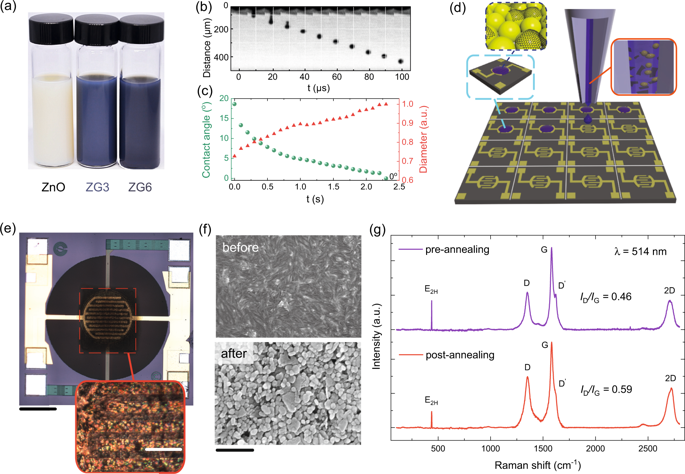npj 2D Materials and Applications ( IF 9.1 ) Pub Date : 2019-11-05 , DOI: 10.1038/s41699-019-0125-3 Tien-Chun Wu , Andrea De Luca , Qinyu Zhong , Xiaoxi Zhu , Osarenkhoe Ogbeide , Doo-Seung Um , Guohua Hu , Tom Albrow-Owen , Florin Udrea , Tawfique Hasan

|
Early diagnosis in exhaled breath is a key technology for next-generation personal healthcare monitoring. Current chemiresistive sensors, primarily based on metal oxide (MOx) thin films, have limited applicability in such portable systems due to their high power consumption, long recovery time, poor device-to-device consistency, and baseline drifts. To address these challenges for ammonia (\({{\rm{NH}}}_{3}\)) detection in exhaled breath, a critical biomarker for a variety of kidney and liver problems, we present a formulation of a graphene–MOx functional ink-based sensing platform. We integrate our sensing layer directly onto miniaturized CMOS microhotplates (μHP) via inkjet printing, potentially enabling scalability and device-to-device performance repeatability. Using stage-by-stage temporal analysis, and a temperature-pulsed modulation (TM) strategy, we achieve ultrahigh responsivity (1500% at 10 ppm pure \({{\rm{NH}}}_{3}\)), fast response and recovery time (28 and 43 s), ultralow power consumption (~6 mW), negligible baseline drift (<0.67%), excellent cross-device and cross-cycle consistency (<0.5% and <0.41% variation in responsivity) and long-term stability (<1% variation) in our graphene–zinc oxide (ZnO) formulation, outperforming conventional MOx chemiresistive sensors. We further mitigate the effect of humidity through our measurement protocols, while interference from acetone is compensated through the parallel deployment of an additional inkjet printed graphene–tungsten oxide (\({{\rm{WO}}}_{3}\)) device as part of the sensor array. Our dual graphene–MOx formulations and their integration with ultralow power CMOS through inkjet printing represent a significant step towards reliable and portable multi-analyte breath diagnostics.
中文翻译:

喷墨印刷的CMOS集成石墨烯-金属氧化物传感器,用于呼吸分析
呼气的早期诊断是下一代个人医疗保健监测的关键技术。当前主要基于金属氧化物(MOx)薄膜的化学传感器,由于其功耗高,恢复时间长,设备间一致性差以及基线漂移等原因,在此类便携式系统中的适用性有限。解决氨的这些挑战(\({{\ rm {NH}}} _ {3} \))呼气中的检测,这是各种肾脏和肝脏问题的关键生物标志物,我们提出了一种基于石墨烯-MOx功能性墨水的感测平台。我们通过喷墨打印将传感层直接集成到微型CMOS微热板(μHP)上,从而有可能实现可扩展性和设备到设备的性能可重复性。使用逐步的时间分析和温度脉冲调制(TM)策略,我们实现了超高的响应度(在10 ppm纯\({{\ rm {NH}}} _ {3} \时达到1500%),快速的响应和恢复时间(28和43 s),超低功耗(〜6 mW),可忽略的基线漂移(<0.67%),出色的跨器件和跨周期一致性(<0.5%和<0.41%差异)在石墨烯-氧化锌(ZnO)配方中的响应性和长期稳定性(变化小于1%)方面,优于传统的MOx化学阻性传感器。我们通过测量协议进一步减轻了湿度的影响,同时通过并行部署附加的喷墨打印石墨烯-氧化钨(\({{\ rm {WO}}} _ {3} \)来补偿丙酮的干扰。)设备作为传感器阵列的一部分。我们的双石墨烯-MOx配方及其通过喷墨打印与超低功耗CMOS的集成代表了迈向可靠且便携式的多分析物呼吸诊断的重要一步。











































 京公网安备 11010802027423号
京公网安备 11010802027423号